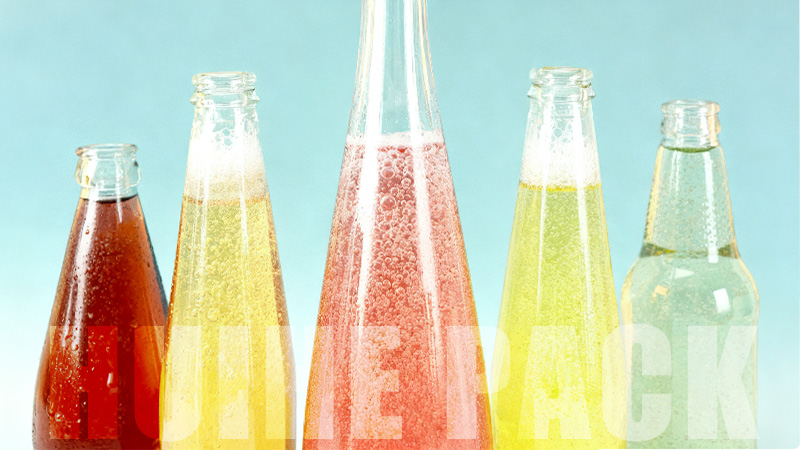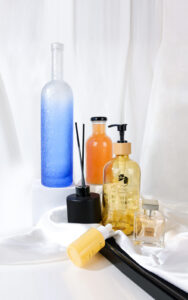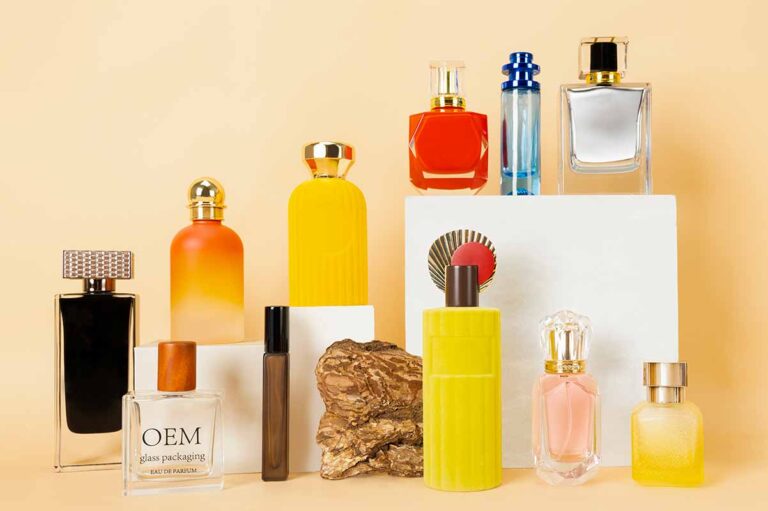Introduction: Why “Taste” Changes with Packaging
Have you ever noticed how your favorite soda seems to taste better when it’s in a glass bottle? It’s not your imagination. The type of packaging you drink from can subtly change how you perceive flavor, aroma, and even texture. From the material’s chemical stability to how it preserves carbonation, packaging plays a major role in how “fresh” and satisfying a soft drink feels.
1-Minute Summary
Soft drinks taste better in glass bottles primarily because glass is chemically inert—no acetaldehyde or antimony migration that can alter flavor; it also offers three times lower CO₂ permeability than PET, preserving carbonation and perceived freshness.

The Science of Glass Bottles vs Plastic & Aluminium
Glass: Inert, Non-Porous, Chemically Stable
Glass is made from natural materials such as sand, soda ash, and limestone. Unlike plastic or aluminum, it’s completely inert — it doesn’t react with or release chemicals into your drink. The U.S. FDA classifies glass as safe and non-toxic for all food and beverage contact. That means no BPA, no resin coatings, and no flavor-altering substances like acetaldehyde or antimony. For soft drink brands that care about purity and product consistency, glass simply keeps the formula exactly as intended.
Carbonation and Fizz Retention
If you’ve ever opened a plastic bottle of soda after a few months, you might notice it tastes flat. That’s because PET bottles allow slow CO₂ loss over time. Glass, on the other hand, has about three times lower CO₂ permeability, helping drinks stay crisp and bubbly for longer.
Studies show that carbonation in glass-bottled soft drinks lasts 3–6 months longer than in plastic bottles — a major advantage for brands focused on taste and shelf stability. The rigid structure and tight seal of glass help lock in carbonation, so your customers experience that refreshing fizz every time they open a bottle.
Temperature, Touch & Drinking Experience
Glass bottles not only look premium but feel better in hand. They cool faster and hold their temperature longer, giving that satisfying chill every time you sip. The solid weight and clarity of glass also enhance the drinking ritual — from the first clink to the final pour. It’s a multisensory experience plastic or aluminum can’t quite match.
Aroma, Flavour & Packaging Interactions
Flavor isn’t just about taste — it’s about smell and freshness, too. Glass is non-porous, so it doesn’t absorb outside odors from storage or shipping environments. It also doesn’t release any of its own compounds, preserving every layer of flavor — the caramel notes of cola, the citrus burst of lemon soda, the tangy fizz of fruit drinks.
In contrast, plastic bottles can slowly absorb oxygen and external scents, dulling the original taste over time, while aluminum cans often carry a faint metallic aftertaste from their internal coatings. Glass keeps the flavor clean, crisp, and authentic — exactly how your recipe was meant to taste.

Consumer Perception & Brand Experience
Emotional & Sensory Cues
Packaging does more than hold a drink — it shapes how people feel about your brand. When consumers pick up a glass bottle, they instantly associate it with quality, nostalgia, and authenticity. The cool touch, the clear view of the liquid, and the signature pop when opening a cap all add to that premium experience.
For many soft drink fans, glass simply “tastes right.” Plastic bottles can leave a faint “plastic note,” especially after being exposed to heat — think of a summer afternoon in a car. In contrast, glass bottles stay neutral and pure, keeping your drink tasting as fresh as when it was bottled. Even the sound and weight of glass trigger positive cues linked to freshness and satisfaction.
From a brand perspective, those small sensory details translate into stronger trust and higher perceived value. A refreshing drink in a glass bottle doesn’t just quench thirst — it strengthens your brand story.
Brand Case Studies
Let’s look at two common challenges beverage brands face — and how glass packaging helps solve them.
1. Packaging impacts brand perception.
A boutique soda startup once struggled with customer feedback — people loved the flavor but complained it “tasted flat” and “felt cheap” in plastic bottles. After switching to custom glass bottles, the brand saw a 23% increase in repeat purchases within six months. Consumers began describing the product as “premium” and “authentic,” proving that packaging can directly shape taste perception and brand loyalty.
2. Short shelf life increases inventory pressure.
Another mid-size soft drink producer found that its PET-packaged sodas lost carbonation and aroma before the end of their 6-month shelf life, leading to spoilage and higher warehouse losses. By shifting to glass bottles, the company extended its flavor and carbonation stability by 3–6 months, giving them more flexibility in production cycles and reducing overall waste.
From the consumer’s view, the difference is just as clear. When you open two bottles — one glass, one plastic — and leave them out for two hours, the plastic one goes noticeably flat while the glass bottle still sparkles with visible bubbles. That small but powerful difference is why so many brands and customers agree: soft drinks simply taste better in glass.
The science and consumer feedback all point to one conclusion — glass bottles not only protect flavor but also elevate how people experience your brand. If you’re a beverage producer aiming for premium taste and lasting shelf appeal, the next question becomes: how do you choose the right glass bottles for your soft drinks?

How to Choose the Right Glass Bottles for Soft Drinks
When selecting the right glass bottles for your soft drink line, several factors determine both the practicality and the consumer appeal of your packaging. The following checklist can help brands make informed decisions.
Consider Material Quality
Choose food-grade glass that meets international safety standards such as FDA or EU regulations. High-clarity soda-lime glass is widely used for soft drinks because it resists chemical interaction, preserves carbonation, and maintains the beverage’s original taste even after long storage.
Focus on Seal Design
A reliable seal is essential for keeping carbonation and flavor intact. Pay attention to the closure system—whether crown caps or twist-off lids—and the use of food-grade liners or silicone gaskets to ensure airtight performance. A well-designed seal not only extends shelf life but also prevents leakage during transport.
Customize to Match Brand Tone
Beyond function, packaging conveys emotion. Tailored bottle shapes, embossing, and printed logos can highlight a brand’s personality—from vintage soda nostalgia to sleek modern minimalism. Customization helps soft drink brands stand out on shelves and connect more deeply with their target audience.
For brands seeking durable, safe, and customizable glass solutions, partnering with a specialized glass packaging manufacturer ensures every detail—from material formulation to sealing fit—supports product quality and brand image.
Conclusion
As the soft drink market evolves toward premiumization and sustainability, packaging has become more than just a container — it’s a key part of the product experience. Glass bottles offer unmatched advantages in flavor preservation, recyclability, and brand storytelling, helping beverages stand out in a competitive marketplace.
For soft drink producers, investing in the right glass packaging means balancing functionality with emotional appeal — from ensuring carbonation retention to crafting a design that resonates with consumers. A well-chosen bottle can elevate both the taste and the perceived value of your product.
If your brand is exploring durable, high-clarity, and customizable glass bottles for soft drinks, HUIHE PACK can provide tailored solutions to match your market positioning and production needs.

FAQ
Q1. Does soda taste better in a glass bottle?
Yes. Most people agree that soda tastes better in a glass bottle because glass doesn’t react with the drink or alter its flavor. It also seals carbonation better than plastic or aluminum, keeping the soda crisp and refreshing for longer.
Q2. Why do things taste better in a glass bottle?
Glass is chemically inert — it doesn’t leach any compounds into your beverage, even under heat or long storage. That means what you taste is the original formula, without the “plastic” or “metallic” notes sometimes noticed in other containers.
Q3. Why does Pepsi taste better in a glass?
Pepsi, like many carbonated drinks, depends heavily on carbonation and sugar balance. Glass helps retain the right CO₂ pressure, giving you that sharper fizz and cleaner sweetness. Plus, drinking from a chilled glass bottle often enhances the sensory experience through touch and temperature.
Q4. Why did they stop putting soda in glass bottles?
Many beverage companies switched to plastic and aluminum packaging mainly for cost, convenience, and transportation efficiency. However, as sustainability and taste quality gain importance again, more soft drink brands are reintroducing glass bottles for their premium lines.
Q5. Are glass bottles better for the environment?
Yes. Glass is 100% recyclable and can be reused indefinitely without losing quality. It also avoids microplastic pollution, making it a top choice for eco-conscious beverage producers.
Q6. Can you reuse glass soda bottles safely?
You can, but only if the bottle is designed for reuse and properly sterilized. Many commercial soda bottles are now single-use for safety reasons, but glass can be recycled endlessly into new bottles with minimal environmental impact.
Q7. Do glass bottles keep soda fizzy longer?
Absolutely. Glass has extremely low CO₂ permeability—around three times lower than PET plastic. That means less gas escapes, so your soda stays fizzy and fresh even after sitting for a while.




